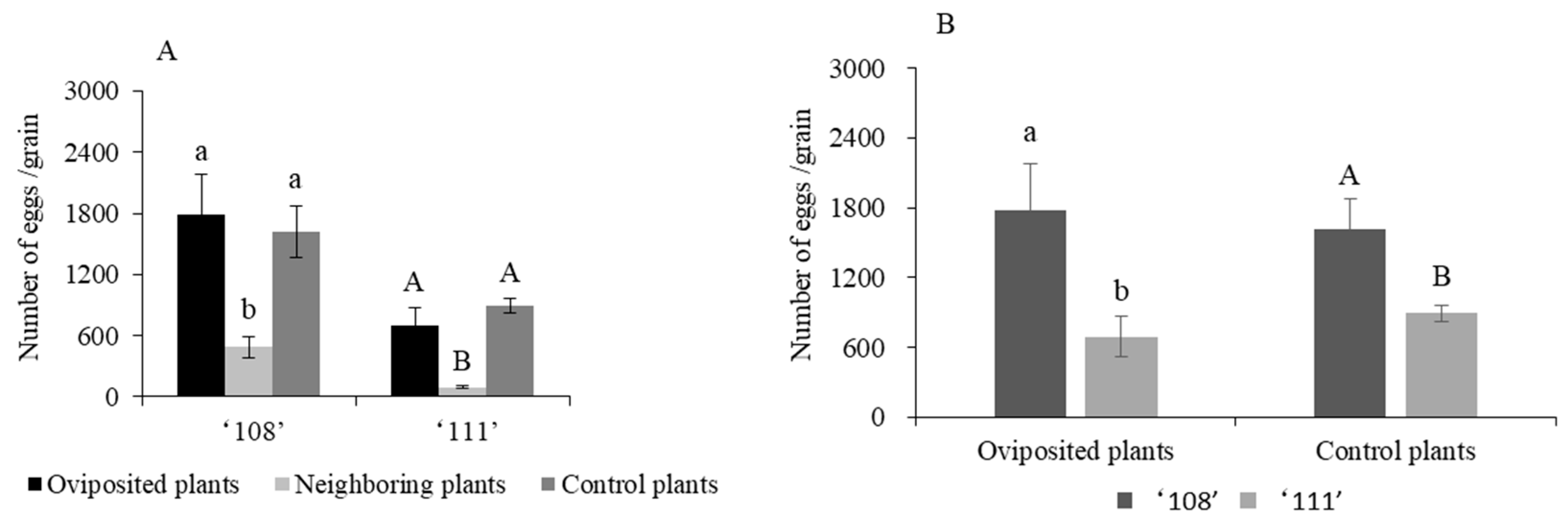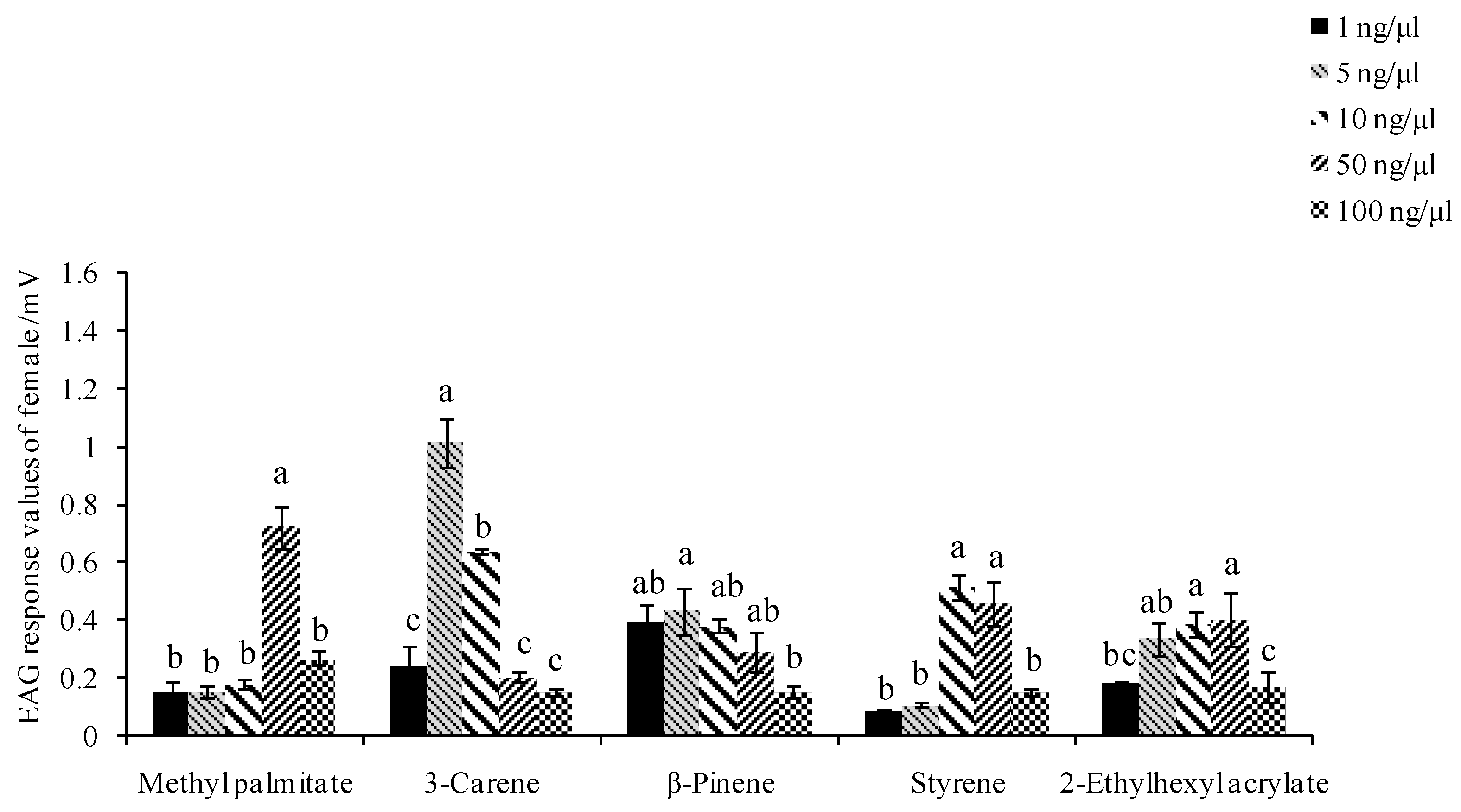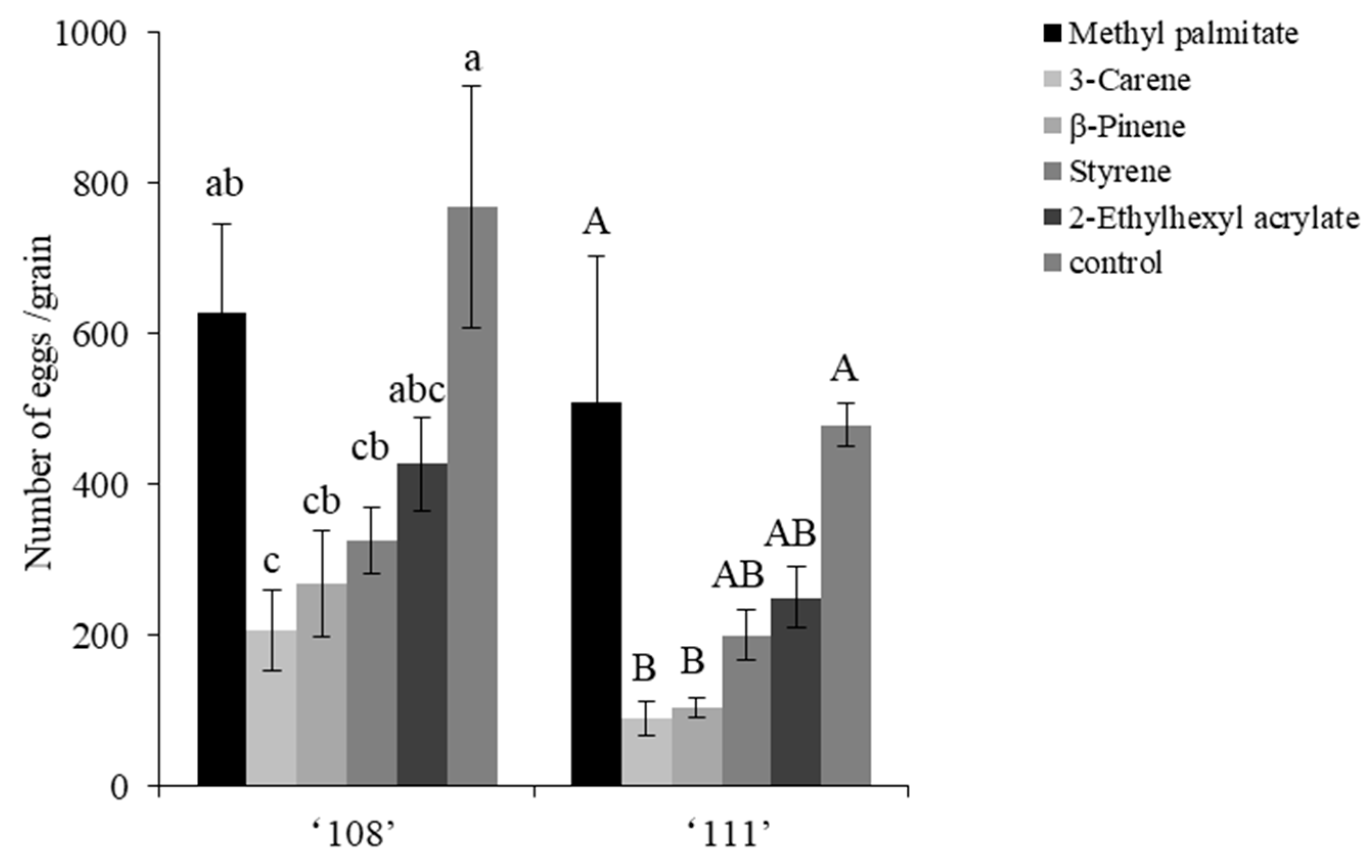Egg Deposition of Micromelalopha sieversi (Staudinger) on Clones of Populus from Section Aigeiros Induces Resistance in Neighboring Plants
Abstract
1. Introduction
2. Materials and Methods
2.1. Plants and Insects
2.2. Oviposition Bioassay I
2.3. Volatile Collection
2.4. Coupled Gas Chromatography-Mass Spectrometry (GC-MS)
2.5. Electroantennogram (EAG) Recording
2.6. Volatile Treatment and Oviposition Bioassay II
3. Results
3.1. Differences in Oviposition among Oviposited Plants, Neighboring Plants, and Control Plants
3.2. Comparison of Volatiles Emitted from Oviposited Plants, Neighboring Plants, and Control Plants
3.3. Electroantennogram (EAG) Response of the Males, Females, and Mated Females to the Five Volatile Compounds
3.4. Differences in Oviposition on the Plants Treated with Volatile Compounds
4. Discussion
5. Conclusions
Author Contributions
Funding
Acknowledgments
Conflicts of Interest
References
- Hilker, M.; Fatouros, N.E. Resisting the onset of herbivore attack: Plants perceive and respond to insect eggs. Curr. Opin. Plant Biol. 2016, 32, 9–16. [Google Scholar] [CrossRef] [PubMed]
- Hilker, M.; Meiners, T. Early herbivore alert: Insect eggs induce plant defense. J. Chem. Ecol. 2006, 32, 1379–1397. [Google Scholar] [CrossRef] [PubMed]
- Doss, R.P.; Oliver, J.E.; Proebsting, W.M.; Potter, S.W.; Kuy, S.R.; Clement, S.L.; Williamson, R.T.; Carney, J.R.; Devilbiss, E.D. Bruchins-insect-derived plant regulators that stimulate neoplasm formation. Proc. Natl. Acad. Sci. USA 2000, 97, 6218–6223. [Google Scholar] [CrossRef] [PubMed]
- Shapiro, A.M.; Devay, J.E. Hypersensitivity reaction of Brassica nigra L. (Cruciferae) kills eggs of Pieris butterflies (Lepidoptera: Pieridae). Oecologia 1987, 71, 631–632. [Google Scholar] [CrossRef] [PubMed]
- Balbyshev, N.F.; Lorenzen, J.H. Hypersensitivity and egg drop, a novel mechanism of host-plant resistance to Colorado potato beetle (Coleoptera: Chrysomelidae). J. Econ. Entomol. 1997, 90, 652–657. [Google Scholar] [CrossRef]
- Seino, Y.; Suzuki, Y.; Sogawa, K. An ovicidal substance produced by rice plants in response to oviposition by the Whitebacked Planthopper, Sogatella furcifera (Horváth) (Homoptera: Delphacidae). Appl. Entomol. Zool. 1996, 31, 467–473. [Google Scholar] [CrossRef]
- Suzuki, Y.; Sogawa, K.; Seino, Y. Ovicidal reaction of rice plants against the Whitebacked Planthopper, Sogatella furcifera Horváth (Homoptera: Delphacidae). Appl. Entomol. Zool. 1996, 31, 111–118. [Google Scholar] [CrossRef]
- Yamasaki, M.; Yoshimura, A.; Yasui, H. Genetic basic of ovicidal response to Whitebacked Planthopper (Sogatella furcifera Horváth) in rice (Oryza sativa L.). Mol. Breed. 2003, 12, 133–143. [Google Scholar] [CrossRef]
- Blaakmeer, A.; Hagenbeek, D.; Beek, T.A.V.; Groot, A.D.; Schoonhoven, L.M.; van Loon, J.J. Plant response to eggs vs. host marking pheromone as factors inhibiting oviposition by Pieris brassicae. J. Chem. Ecol. 1994, 20, 1657–1665. [Google Scholar] [CrossRef]
- Dicke, M.; van Loon, J.J. Multitrophic effects of herbivore-induced plant volatiles in an evolutionary context. Entomol. Exp. Appl. 2000, 97, 237–249. [Google Scholar] [CrossRef]
- Kessler, A.; Heil, M. The multiple faces of indirect defences and their agents of natural selection. Funt. Ecol. 2011, 25, 348–357. [Google Scholar] [CrossRef]
- Meiners, T.; Hilker, M. Host location in Oomyzus gallerucae (Hymenoptera: Eulophidae), an egg parasitoid of the elm leaf beetle Xanthogaleruca luteola (Coleoptera, Chrysomelidae). Oecologia 1997, 112, 87–93. [Google Scholar] [CrossRef] [PubMed]
- Wegener, R.; Schulz, S.; Meiners, T.; Hadwich, K.; Hilker, M. Analysis of volatiles induced by oviposition of elm leaf beetle Xanthogaleruca luteola on Ulmus minor. J. Chem. Ecol. 2001, 27, 499–515. [Google Scholar] [CrossRef]
- Colazza, S.; Fucarino, A.; Peri, E.; Salerno, G.; Conti, E.; Bin, F. Insect oviposition induces volatile emission in herbaceous plants that attracts egg parasitoids. J. Exp. Biol. 2004, 207, 47–53. [Google Scholar] [CrossRef] [PubMed]
- Hilker, M.; Kobs, C.; Varama, M.; Schrank, K. Insect egg deposition induces Pinus sylvestris to attract egg parasitoids. J. Exp. Biol. 2002, 205, 455–461. [Google Scholar]
- Mumm, R.; Schrank, K.; Wegener, R.; Schulz, S.; Hilker, M. Chemical analysis of volatiles emitted by Pinus sylvestris after induction by insect oviposition. J. Exp. Biol. 2003, 29, 1235–1252. [Google Scholar]
- Meiners, T.; Hilker, M. Induction of plant synomones by oviposition of a phytophagous insect. J. Exp. Biol. 2000, 26, 221–232. [Google Scholar]
- Colazza, S.; Mcelfresh, J.S.; Millar, J.G. Identification of volatile synomones, induced by Nezara viridula feeding and oviposition on bean spp., that attract the egg parasitoid Trissolcus basalis. J. Exp. Biol. 2004, 30, 945–964. [Google Scholar] [CrossRef]
- Schoonhoven, L.M.; Jermy, T.; van Loon, J.J. Host-Plant Selection: How to Find a Host Plant. In Insect-Plant Biology; Springer US: New York, NY, USA, 1998; pp. 121–153. [Google Scholar]
- Guo, X. The effects of withering poplar branch on the reproductive behavior of cotton bollworm. J. Plant Protect. 2003, 30, 148–152. [Google Scholar]
- Leather, S.R.; Watt, A.D.; Forrest, G.I. Insect-induced chemical changes in young lodgepole pine (Pinus contorta): The effect of previous defoliation on oviposition, growth and survival of the pine beauty moth, Panolis flammea. Ecol. Entomol. 2010, 12, 275–281. [Google Scholar] [CrossRef]
- Meiners, T.; Hacker, N.; Anderson, P.; Hilker, M. Response of the elm leaf beetle to host plants induced by oviposition and feeding: the infestation rate matters. Entomol. Exp. Appl. 2005, 115, 171–177. [Google Scholar] [CrossRef]
- Landolt, P.J. Effects of host plant leaf damage on cabbage looper moth attraction and oviposition. Entomol. Exp. Appl. 2011, 67, 79–85. [Google Scholar] [CrossRef]
- Karban, R.; Shiojiri, K.; Ishizaki, S. An air transfer experiment confirms the role of volatile cues in communication between plants. Am. Nat. 2010, 176, 381–384. [Google Scholar] [CrossRef] [PubMed]
- Heil, M.; Bueno, J.C.S. Within-plant signaling by volatiles leads to induction and priming of an indirect plant defense in nature. Proc. Natl. Acad. Sci. USA 2007, 104, 5467–5472. [Google Scholar] [CrossRef] [PubMed]
- Frost, C.J.; Appel, H.M.; Carlson, J.E.; Moraes, C.M.D.; Mescher, M.C.; Schultz, J.C. Within-plant signalling via volatiles overcomes vascular constraints on systemic signalling and primes responses against herbivores. Ecol. Lett. 2007, 10, 490–498. [Google Scholar] [CrossRef] [PubMed]
- Rodriguezsaona, C.R.; Rodriguezsaona, L.E.; Frost, C.J. Herbivore-induced volatiles in the perennial shrub, Vaccinium corymbosum, and their role in inter-branch signaling. J. Chem. Ecol. 2009, 35, 163–175. [Google Scholar] [CrossRef] [PubMed]
- Karban, R. The ecology and evolution of induced resistance against herbivores. Funct. Ecol. 2011, 25, 339–347. [Google Scholar] [CrossRef]
- Bruin, J.; Dicke, M. Chemical information transfer between wounded and unwounded plants: backing up the future. Biochem. Syst. Ecol. 2001, 29, 1103–1113. [Google Scholar] [CrossRef]
- Karban, R. Communication between sagebrush and wild tobacco in the field. Biochem. Syst. Ecol. 2001, 29, 995–1005. [Google Scholar] [CrossRef]
- Karban, R.; Shiojiri, K.; Huntzinger, M.; Mccall, A.C. Damage-induced resistance in Sagebrush: volatiles are key to intra- and interplant communication. Ecology 2006, 87, 922–930. [Google Scholar] [CrossRef]
- Fan, L.P.; Wang, J.H.; Yu, Z.J.; Huang, F.Q.; Kong, X.B.; Wang, H.B.; Zhang, S.F.; Zhang, Z. Host selection behavior of Micromelalopha sieversi (Staudinger) to five Populus deltoids clones. For. Res. 2014, 27, 459–465. [Google Scholar]
- Kong, X.B.; Zhang, Z.; Wang, H.B.; Yang, J.; Hu, Y.T. Analysis of Platycladus orientalis volatiles and their electroantennogram responses with Semanotus bifasciatus. For. Res. 2005, 20, 260–266. [Google Scholar]
- Guo, A.J.; Li, L.M. Composition and antibacterial effect of volatile organic compounds of Rosa multiflora var. cathayensis. J. Northeast For. Univ. 2016, 44, 81–84. [Google Scholar]
- He, L.Z.; Wang, J.; Zhao, Z.D.; Chen, Y.X.; Gu, Y. Research progress on resources and bioactivity applications of 3-Carene. Chem. Ind. For. Prod. 2011, 31, 122–126. [Google Scholar]
- Li, S.Q.; Zhang, Z.N. EAG responses of Monochamus alternatus Hope (Coleoptera: Cerambycidae) to volatiles from larval frass and the repellency tests in fields. Acta Entomol. Sin. 2008, 51, 284–289. [Google Scholar]
- Liu, Y.S.; Yan, S.C.; Cheng, H.; Wang, Q.; Wen, P.; Wang, Y.J. Behavioural responses of Dendrolimus superans to Dahurin Larch and its nine volatiles. Sci. Silvae Sin. 2009, 45, 72–77. [Google Scholar]
- Zhao, C.H.; Yan, Y.H. Oviposition behavior of the pine caterpillar moth, Dendrolimus punctatus influenced by needle volatiles of Pinus massoniana. Sci. Silvae Sin. 2003, 39, 91–93. [Google Scholar]
- Zhu, N.; Zhang, D.Y.; Shen, H.X.; Hu, Q.; Fan, J.T. Oviposition preferences of Anoplophora glabripennis on three host plants and composition analysis of host plant volatiles. J. Zhejiang A. F. Univ. 2017, 34, 1059–1064. [Google Scholar]
- Wang, Y.N.; Wang, H.X.; Shen, Z.J.; Zhao, L.L.; Clarke, S.R.; Sun, J.H.; Du, Y.Y.; Shi, G.L. Methyl palmitate, an acaricidal compound occurring in green walnut husks. J. Econ. Entomol. 2009, 102, 196–202. [Google Scholar] [CrossRef]
- Wang, Y.N.; Shi, G.L.; Ren, J.J.; Zhao, L. Acaricidal activity of methyl palmitate to T. cinnabarinus. In Proceedings of the 3rd International Conference on Bioinformatics and Biomedical Engineering, Beijing, China, 11–13 June 2009; IEEE Xplore Digital Library: Miami, FL, USA; pp. 1–4. [Google Scholar]
- Reymond, P. Perception, signaling and molecular basis of oviposition-mediated plant responses. Planta 2013, 238, 247–258. [Google Scholar] [CrossRef]
- Bi, Y.G.; Guo, L.; Wang, Z.G.; Lv, F.; Yan, A.H. Electroantennogram and behavioral responses of Apriona germari to five plant volatiles and their mixtures. Sci. Seric. 2017, 43, 32–38. [Google Scholar]
- Ma, Y.; Shi, L.Y.; Zhao, Y.; Xu, H.C. Comparison of volatiles released from the host Juglans mandshurica in different damaged states and the GC-EAD and behavioral responses of Apriona germari (Coleoptera: Cerambycidae) to these volatiles. Acta Entomol. Sin. 2018, 61, 574–584. [Google Scholar]
- Balakrishnan, K.; Holighaus, G.; Weißbecker, B.; Schütz, S. Electroantennographic responses of red flour beetle tribolium castaneum Herbst (coleoptera: Tenebrionidae) to volatile organic compounds. J. Appl. Entomol. 2017, 141, 477–489. [Google Scholar] [CrossRef]
- Vanderpers, J. Comparison of electroantennogram response spectra to plant volatiles in 7 species of yponomeuta and in the tortricid adoxophyes-orana. Entomol. Exp. Appl. 2011, 30, 181–192. [Google Scholar]
- Light, D.M.; Kamm, J.A.; Buttery, R.G. Electroantennogram response of alfalfa seed chalcid, Bruchophagus roddi (Hymenoptera: Eurytomidae) to host- and nonhost-plant volatiles. J. Chem. Ecol. 1992, 18, 333–352. [Google Scholar] [CrossRef] [PubMed]
- Raguso, R.A.; Light, D.M.; Pickersky, E. Electroantennogram responses of Hyles lineata (Sphingidae: Lepidoptera) to volatile compounds from Clarkia breweri (Onagraceae) and other moth-pollinated flowers. J. Chem. Ecol. 1996, 22, 1735–1766. [Google Scholar] [CrossRef] [PubMed]
- Hernándze, M.M.; Sanz, I.; Anelantado, M.; Ballach, S.; Primo, E. Electroantennogram activity from antennae of Ceratitis capitata (Wied.) to fresh orange airborne volatiles. J. Chem. Ecol. 1996, 22, 1607–1619. [Google Scholar] [CrossRef]
- Chinta, S.; Dickens, J.C.; Aldrich, J.R. Olfactory reception of potential pheromones and plant odors by tarnished plant bug, Lygus lineolaris (Hemiptera: Miridae). J. Chem. Ecol. 1994, 20, 3251–3267. [Google Scholar] [CrossRef]
- Shu, S.; Grant, G.G.; Langevin, D.; Lombardo, D.A.; MacDonald, L. Oviposition and electroantennogram responses of Dioryctria abietivorella, (lepidoptera: pyralidae) elicited by monoterpenes and enantiomers from eastern white pine. J. Chem. Ecol. 1997, 23, 35–50. [Google Scholar] [CrossRef]
- Conti, E.; Salerno, G.; Leombruni, B.; Frati, F.; Bin, F. Short-range allelochemicals from a plant-herbivore association: a singular case of oviposition-induced synomone for an egg parasitoid. J. Exp. Biol. 2010, 213, 3911–3919. [Google Scholar] [CrossRef]
- Moraes, C.B.M.; Pareja, M.; Laumann, R.A.; Hoffman-Campo, C.B.; Borges, M. Response of the parasitoid Telenomus podisi to induced volatiles from soybean damaged by stink bug herbivory and oviposition. J. Plant Inter. 2008, 3, 111–118. [Google Scholar]







| Compound Composition of ‘108’ | Oviposited-24 h | Neighboring-24 h | Control-24 h | Oviposited-48 h | Neighboring-48 h | Control-48 h | Oviposited-72 h | Neighboring-72 h | Control-72 h |
|---|---|---|---|---|---|---|---|---|---|
| Relative Content (%) | |||||||||
| p-Xylene | 3.79 ± 0.08 a | 1.32 ± 0.06 b | 1.05 ± 0.09 b | 4.45 ± 0.19 a | 1.26 ± 0.08 b | 0.85 ± 0.04 b | 2.21 ± 0.06 b | 3.41 ± 0.19 a | 1.81 ± 0.12 b |
| Styrene | 8.08 ± 0.28 a | 2.70 ± 0.46 b | 3.19 ± 0.10 b | 8.46 ± 0.06 a | 2.70 ± 0.12 c | 5.79 ± 0.13 b | 2.77 ± 0.04 b | 3.98 ± 0.22 b | 6.09 ± 0.62 a |
| 3-Carene | 9.65 ± 0.58 a | 4.63 ± 0.52 b | 1.26 ± 0.17 c | 14.22 ± 0.77 a | 4.29 ± 0.10 b | 1.85 ± 0.09 c | 6.82 ± 0.12 b | 9.26 ± 0.72 a | 1.51 ± 0.06 c |
| β-Pinene | 2.17 ± 0.12 a | 0.42 ± 0.03 b | 0.00 ± 0.00 c | 1.63 ± 0.13 a | 0.28 ± 0.01 b | 0.00 ± 0.00 c | 2.22 ± 0.07 a | 2.49 ± 0.12 a | 0.00 ± 0.00 b |
| 1,3-Diethylbenzene | 0.00 ± 0.00 b | 17.44 ± 1.20 a | 0.00 ± 0.00 b | 0.00 ± 0.00 b | 21.53 ± 0.75 a | 0.00 ± 0.00 b | 0.00 ± 0.00 b | 18.12 ± 1.05 a | 0.00 ± 0.00 b |
| 1,4-Diethylbenzene | 0.00 ± 0.00 b | 22.35 ± 1.11 a | 0.00 ± 0.00 b | 0.00 ± 0.00 b | 28.15 ± 1.54 a | 0.00 ± 0.00 b | 0.00 ± 0.00 b | 12.03 ± 1.27 a | 0.00 ± 0.00 b |
| 2-Ethylhexyl acrylate | 2.21 ± 0.06 a | 0.55 ± 0.01 c | 1.45 ± 0.03 b | 5.73 ± 0.08 a | 0.82 ± 0.03 c | 1.78 ± 0.35 b | 0.83 ± 0.08 b | 1.74 ± 0.05 a | 1.86 ± 0.10 a |
| 2,6,10-Trimethyl tetradecane | 5.26 ± 0.04 b | 1.99 ± 0.16 c | 12.80 ± 0.81 a | 2.55 ± 0.12 b | 1.33 ± 0.10 b | 12.36 ± 0.79 a | 1.36 ± 0.09 b | 1.83 ± 0.08 b | 13.33 ± 0.71 a |
| C26H42O4 (Unknown) | 6.75 ± 0.23 a | 3.73 ± 0.19 b | 6.63 ± 0.17 a | 4.46 ± 0.14 b | 2.80 ± 0.23 c | 6.09 ± 0.12 a | 3.85 ± 0.21 b | 2.29 ± 0.13 c | 6.81 ± 0.44 a |
| Methyl palmitate | 61.71 ± 0.88 a | 38.61 ± 1.97 b | 67.61 ± 1.67 a | 54.47 ± 0.42 b | 28.38 ± 0.13 c | 67.84 ± 1.42 a | 69.90 ± 2.83 a | 26.67 ± 1.54 b | 63.32 ± 1.80 a |
| Composition Compound of ‘111’ | Oviposited-24 h | Neighboring-24 h | Control-24 h | Oviposited-48 h | Neighboring-48 h | Control-48 h | Oviposited-72 h | Neighboring-72 h | Control-72 h |
|---|---|---|---|---|---|---|---|---|---|
| Relative Content (%) | |||||||||
| p-Xylene | 8.90 ± 0.81 a | 4.05 ± 0.10 b | 2.05 ± 0.10 c | 2.85 ± 0.09 b | 3.61 ± 0.11 a | 3.46 ± 0.07 a | 3.32 ± 0.06 b | 3.98 ± 0.18 a | 2.07 ± 0.15 c |
| Styrene | 15.52 ± 1.34 a | 9.75 ± 0.64 b | 17.82 ± 1.04 a | 4.62 ± 0.18 b | 7.82 ± 0.18 a | 8.23 ± 0.25 a | 3.15 ± 0.03 c | 6.21 ± 0.22 b | 8.31 ± 0.41 a |
| 3-Carene | 20.46 ± 1.13 a | 12.53 ± 0.71 b | 5.53 ± 0.17 c | 7.97 ± 0.21 b | 10.79 ± 0.12 a | 5.14 ± 0.02 c | 7.33 ± 0.06 b | 9.82 ± 0.65 a | 4.40 ± 0.06 c |
| β-Pinene | 1.65 ± 0.09 a | 0.18 ± 0.01 b | 0.00 ± 0.00 c | 0.36 ± 0.01 b | 1.09 ± 0.04 a | 0.00 ± 0.00 c | 1.34 ± 0.07 a | 0.94 ± 0.08 b | 0.00 ± 0.00 c |
| 2-Ethylhexyl acrylate | 5.72 ± 0.18 a | 3.55 ± 0.09 c | 4.78 ± 0.09 b | 7.77 ± 0.27 a | 4.06 ± 0.03 b | 8.85 ± 0.78 a | 4.99 ± 0.14 a | 6.54 ± 0.38 a | 7.41 ± 0.88 a |
| 2,6,10-Trimethyl tetradecane | 1.20 ± 0.09 b | 2.13 ± 0.04 a | 2.00 ± 0.19 a | 2.06 ± 0.02 b | 2.23 ± 0.12 b | 3.59 ± 0.21 a | 1.14 ± 0.03 b | 1.67 ± 0.10 b | 3.52 ± 0.07 a |
| C26H42O4 (Unknown) | 2.63 ± 0.06 b | 5.55 ± 0.08 a | 5.77 ± 0.13 a | 4.90 ± 0.17 b | 5.28 ± 0.06 b | 7.96 ± 0.18 a | 3.18 ± 0.10 b | 3.17 ± 0.10 b | 6.97 ± 0.27 a |
| Methyl palmitate | 41.52 ± 1.42 b | 59.84 ± 0.23 a | 59.66 ± 1.41 a | 64.17 ± 1.25 a | 63.48 ± 0.85 a | 55.87 ± 0.50 b | 72.95 ± 0.98 a | 60.26 ± 1.18 b | 59.49 ± 1.66 b |
© 2019 by the authors. Licensee MDPI, Basel, Switzerland. This article is an open access article distributed under the terms and conditions of the Creative Commons Attribution (CC BY) license (http://creativecommons.org/licenses/by/4.0/).
Share and Cite
Guo, L.; Liu, F.; Zhang, S.; Kong, X.; Zhang, Z. Egg Deposition of Micromelalopha sieversi (Staudinger) on Clones of Populus from Section Aigeiros Induces Resistance in Neighboring Plants. Forests 2019, 10, 110. https://doi.org/10.3390/f10020110
Guo L, Liu F, Zhang S, Kong X, Zhang Z. Egg Deposition of Micromelalopha sieversi (Staudinger) on Clones of Populus from Section Aigeiros Induces Resistance in Neighboring Plants. Forests. 2019; 10(2):110. https://doi.org/10.3390/f10020110
Chicago/Turabian StyleGuo, Li, Fu Liu, Sufang Zhang, Xiangbo Kong, and Zhen Zhang. 2019. "Egg Deposition of Micromelalopha sieversi (Staudinger) on Clones of Populus from Section Aigeiros Induces Resistance in Neighboring Plants" Forests 10, no. 2: 110. https://doi.org/10.3390/f10020110
APA StyleGuo, L., Liu, F., Zhang, S., Kong, X., & Zhang, Z. (2019). Egg Deposition of Micromelalopha sieversi (Staudinger) on Clones of Populus from Section Aigeiros Induces Resistance in Neighboring Plants. Forests, 10(2), 110. https://doi.org/10.3390/f10020110






